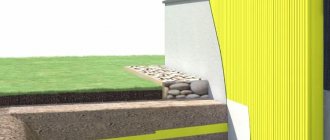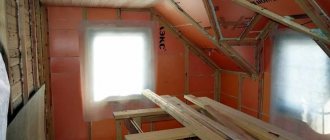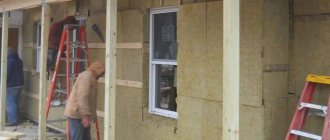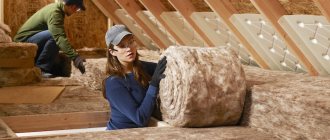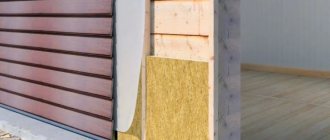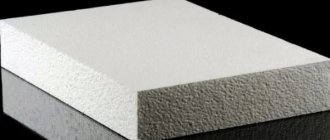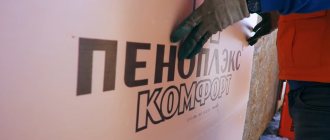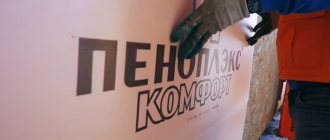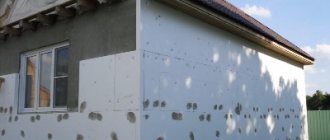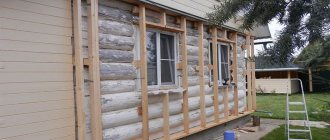Properly carried out floor insulation work is the key to maintaining a comfortable temperature in the house and minimal heat loss. Such work can be carried out both during the construction of a new building and in existing houses, for example, insulating the floor in a wooden house from below from the basement. Not only high-quality floor insulation, but also the correct choice of heat-insulating material will help achieve energy savings and reduce heat losses by up to 20%.
The presence of a basement in the house allows you to insulate the floor from below Source oig-homes.com
Advantages of bottom insulation
From the point of view of labor costs, it is more profitable to insulate the floor from above. In this case, the insulating layer is mounted between the frame (joists) and the top finishing layer.
But in some situations, bottom insulation is preferable.
This method of thermal insulation is most often used in private houses with an uninsulated basement, garage, and in frame buildings on pile and pile-screw foundations.
Bottom insulation has a number of advantages:
- the insulation layer is not subject to loads from furniture standing on the floor and people moving around the house, so you can use thermal insulation material of any hardness;
- the height of the room does not decrease;
- Not only the top flooring, but also the entire floor frame is protected from freezing, which reduces the likelihood of freezing and water getting on the wood - this increases the service life of wooden structures and ensures their reliability.
It is more expedient to insulate a house on stilts from below Source valet.ru
Which insulation materials to choose for insulation
An important stage in the internal insulation of a basement, especially when it comes to walls and ceilings, is the selection of insulation. The final result will depend on how high quality it is (we are talking about the coefficient of thermal conductivity and resistance to moisture).
There are many options for insulation on the market, including those suitable for internal insulation. Below are the most proven and accessible of them.
Polystyrene foam is the most budget option, but has a serious drawback - lack of resistance to mechanical damage and extremely low or high temperatures. The material has been used for thermal insulation for several decades, being preferred primarily due to its affordable price.
To insulate the basement, polystyrene foam is used only if there are no other options. The insulation will not be able to reliably protect surfaces from cold and moisture, and therefore will require additional vapor-waterproofing to avoid premature wear.
Another option is penoplex. The material is more convenient and effective for a private home than the foam described above, but will cost more. They install penoplex in the form of slabs according to the described algorithm, not forgetting about the cold “bridges” that are inevitable with a careless approach to the processing of joints.
To achieve maximum results, penoplex for internal insulation is used in conjunction with more advanced thermal insulation for insulating walls outside, for example, polyurethane foam.
This material is resistant to mechanical damage and proves itself to be a modern insulation worthy of respect and trust. The disadvantage of the material is the complexity of installation. To apply insulation you will need a special installation operating under high pressure.
Among the advantages, it is worth highlighting persistent protection from moisture without the need to install an additional layer, room tightness, and biological neutrality.
Expanded polystyrene, an example of modern thermal insulation with properties similar to penoplex, can also be a suitable option for insulating a private home.
Thermal insulation materials
The choice of insulation for a wooden house is based on two criteria: non-flammability and the ability to resist the formation of mold fungi and other microorganisms. But when choosing a material for lower insulation, the specific situation and the intended installation method are taken into account.
Before purchasing materials, it is better to consult with a contractor than to insulate the floor in a private house from below. Most often used:
- mineral wool;
- Styrofoam;
- penoplex;
- penofol;
- expanded clay
Mineral wool is considered one of the best insulation materials, so many people prefer it. A plus is good sound insulation performance. Cotton wool is not subject to biological destruction and does not burn.
Cons: low mechanical strength and deterioration of thermal insulation properties when exposed to water or steam. Therefore, when using, special attention should be paid to vapor and waterproofing. Cotton wool can be presented in flexible rolls or dense slabs.
Mineral wool in slabs is often used for insulation on the basement side Source silastroy.com
See also: Catalog of companies that specialize in home insulation.
Polystyrene foam is another popular insulation material. Combines the good qualities of mineral wool and mechanical strength. But in case of possible fire it releases toxic substances. Thanks to its structure, it retains heat well and ensures minimal heat loss. Long service life eliminates the need for replacement, but the ability to absorb moisture may negatively affect some characteristics.
Penoplex . A recently appeared material is based on polystyrene, into which gas is introduced. The mass is foamed and squeezed into molding containers. The gas evaporates and the output is a sheet of insulation with many pores. This is a material with unique thermal insulation characteristics, very light, and easy to install. Durability and immunity to biological organisms ensure a long service life. The material is not flammable, does not emit harmful substances and does not absorb water.
Penofol is a material for the production of which foamed polyethylene is used. An aluminum film is applied to its top layer, which reflects heat, giving the room the characteristics of a thermos. The structure of penofol does not contain pores, which prevents it from allowing air to pass through.
Penofol perfectly reflects heat Source ultra-term.ru
Expanded clay is a bulk material in the form of porous balls, which is formed during the firing of clay or shale. This is a completely environmentally friendly material that has high heat savings, good fire resistance and resistance to freezing. But over time, expanded clay cakes under the influence of gravity and begins to lose quality, so this material must be changed periodically.
To decide how to insulate the floor in a wooden house from below, you need to choose the insulation that will perform the function of a heat insulator better than others in a particular situation.
Basement vapor barrier
Of all the materials that are used today to create a vapor barrier for a room, in our case it is best to take a closer look at membrane films that can stop moisture but allow air to pass through easily.
Any membrane vapor barrier has a certain level of vapor permeability, which ensures normal operation of the insulation. With such vapor protection, the thermal insulation material will not become damp, and the walls will begin to “breathe”, thereby preserving the ability of the insulation to fulfill its direct “responsibilities” for many years.
In the process of gluing the membrane vapor barrier, you must strictly follow the attached instructions so as not to accidentally confuse the outer and inner sides. The installation of the film is carried out, as a rule, overlapping the adjacent canvases by 10-20 cm. The film should also overlap the walls by 10-20 cm. Any seams, even the most invisible ones, should be taped with construction tape.
In addition, it is recommended to glue the canvases in places adjacent to doors and windows, if there are any in the basement. It is strictly not recommended to stretch the membrane film (even slightly). Laying must be done freely. Once everything is dry, you can begin the final stage of finishing the basement wall.
If the basement is intended to be used as a household space (or even a residential one), then it is imperative to think through a heating system for the room, because simple insulation and vapor barrier, of course, will not be enough.
Principles of installation work
Regardless of the choice of type of thermal insulation, it is necessary to follow the sequence of work performed for proper insulation. If we consider the structure from bottom to top, it will look like this:
- waterproofing layer;
- thermal insulation layer;
- vapor barrier layer;
- design for floor installation;
- floor.
Compliance with this order of work guarantees the maintenance of normal temperature conditions in the room and protection of the structure from freezing and rotting.
The easiest way to insulate the bottom is through joists. They are beams measuring 5x10 cm or more, on which the floor is subsequently laid.
Scheme of floor insulation using joists Source nehomesdeaf.org
Bottom line
Let's summarize and consider additional tips. Using penoplex-35 is the best option for thermal insulation of your floor. This material has “poor contact” with substances such as gasoline, ether, acetone, kerosene and others. Bright sunlight should not fall on the foam boards.
If you store the material outdoors, you should make a barrier for the sun's rays to prevent them from entering. It is imperative to make a cement screed, and only then apply the floor covering. The cement screed ensures uniform load distribution.
Floor screed with penoplex is the best option. Insulating the floor with penoplex without a screed does not give the desired result. Penoplex screeds have heating elements.
A self-leveling floor on penoplex is installed if the material has a thickness of 20 millimeters. Extruded polystyrene foam is the most common and durable material. Do not forget to inspect the floor slabs and make sure that they are not damaged in any way.
As we have seen, absolutely anyone can carry out floor insulation with penoplex. It is only necessary to take into account some features of the base on which the penoplex will be installed. Do-it-yourself insulation material for the floor under the screed is a necessary technology.
Sources
- https://ibuildrussia.ru/uteplenie-pola-v-derevyannom-dome-snizu-materialy-i-texnologiya-montazha
- https://re-home.su/remont/uteplenie-pola-v-dome.html
- https://polspec.com/teplyy-pol/uteplenie-pola-v-derevyannom-dome-snizu-kak-sdelat-i-chto-ispolzovat.html
- https://SamoDelino.ru/remont-v-dome-svoimi-rukami/kak-uteplit-v-chastnom-dome-svoimi-rukami.html
- https://DomZastroika.ru/slabs/sposoby-utepleniya-pola-snizu.html
- https://stroitelstvoproektirovanie.com/uteplenie-pola/
- https://banya10.ru/montazh/uteplenie-pola-v-derevyannom-dome-snizu.html
- https://www.tproekt.com/kak-uteplit-pol-v-chastnom-dome/
- https://pol-exp.com/uteplenie-pola-v-derevyannom-dome-snizu/
- https://HouseDerevo.ru/stroitelstvo/uteplit-pol-snizu
Technology and features of floor insulation from below in a wooden house
For each type of insulation, there are some specific features of use.
Mineral wool
The sizes of rolls and slabs are usually multiples of 60 cm, which makes this distance the optimal step between the logs. Mineral wool is cut to size with a cutter and placed in the space between the joists. For a tight fit, the size should be 1–2 cm larger than the distance between the joists. Cotton wool should not be pressed down forcefully as this may affect its characteristics.
The best option would be to lay two layers of insulation. The second layer is laid so that the joint of the lower layer falls on the center of the upper piece. This method of installation will prevent cold air from entering the room.
Ventilation system design
Proper basement ventilation system
To create an optimal microclimate in the basement, good ventilation is needed, the main function of which is to ensure air circulation. If there is no movement of air masses, dampness and humidity will constantly be present in the basement, which, even with high-quality insulation, threatens the appearance of mold and fungal colonies.
To install a ventilation system in the basement, two pipes are installed on different sides, usually on the south and north. One pipe serves to bring in fresh cold air, the other removes warm air from the room.
When installing pipes, you must be guided by the laws of physics, according to which cold air always tends downward, and as it heats up, it rises to the ceiling.
Therefore, the lower part of the supply pipe is located at a distance of 20-30 cm from the basement floor, and the upper part - 40 cm from the ground. The hole in the pipe that goes outside is covered with a fine metal mesh to prevent rodents. The lower part of the exhaust pipe should be 30 cm below the ceiling of the cellar, and its upper part should lead to the roof.
Penoplex and foam plastic
If foam plastic is used when insulating a wooden floor from below in a private house, you must take into account several rules for working with it:
- Foam absorbs water, so waterproofing is required. Many experts do not take this property into account during installation, which leads to a decrease in thermal insulation characteristics.
- It is recommended to cut the sheets not exactly to the size of the gap between the joists, but 1–2 cm smaller. This will allow you to fill the gaps between the sheet and the joist with polyurethane foam, which will increase the thermal insulation properties. The joints between the sheets also need to be foamed.
Sheets can be fastened using slats, spacer wedges or special adhesives.
Floor insulation with foam plastic in a wooden house Source sk-amigo.ru
The principle of working with penoplex is no different. But due to the smaller thickness of the material, it can be laid with overlapping sheet joints to avoid the formation of cold islands (similar to mineral wool).
But this method significantly increases material consumption, which means additional financial costs.
Penofol
Due to its property of not allowing moisture to pass through, penofol does not require additional installation of vapor and waterproofing. But to prevent the water vapor that forms in the room from settling on the insulation layer, an air gap is needed between it and the flooring for air circulation.
Laying is done with the foil side up only. This will allow heat to be reflected, which will increase the temperature in the house. Penofol can be used as waterproofing when laying mineral wool or polystyrene foam. This can increase thermal insulation several times, but this method is quite expensive.
Penofol joints are sealed with adhesive tape Source build.4-u.info
The material is sold in rolls and can be easily cut into pieces of the desired size. Fastening is carried out with a construction stapler on staples or with thin slats that are nailed. To improve the result, it is recommended to lay penofol in several layers.
What should you pay attention to?
The density of the purchased polystyrene foam should be 35 kg per m3 or higher. Materials for work should be purchased only from sellers with a good reputation. Expanded polystyrene boards are often sold with defects, so it is important to visually check their quality before purchasing.
- Saving on the thickness of the insulation can negate the results of the work done.
- For installation of anchors, only high-quality drills should be used.
- With significant ceiling heights, it is safer to use strong sawhorses or low scaffolding than stepladders or chairs.
- It is recommended to hold the hammer drill with both hands, as it may jam during operation.
Types of cellars
The main function of the cellar is to store food, so the location and type of structure are chosen for its arrangement. The most dangerous thing for a storage facility is flooding, as a result of which all supplies will be spoiled. To avoid such a situation, it is necessary to know the groundwater level at the site of the building, and according to this classification, cellars are divided into the following types:
| Cellar view | Ground water level | Design |
| Bulk or underground | Not higher than 2.5 m | It is usually carried out in the form of a rectangular pit (2-3 m underground) under a flat roof or a small superstructure (cellar). More often it is built with access to residential premises. |
| Buried (semi-underground) | Above 2.5 m | The pit is dug less deep (above 1.5 m), and the above-ground part is completed above it. It can be a separate building or have a common wall with the house. |
| Ground | 0.5 m and above | An above-ground structure with a small depth (up to 0.5 m) covered with an embankment on all sides except the doorway. It can be built separately or adjacent to a house or outbuilding. |
All three types of cellars have direct contact of the walls with a thick layer of soil, which allows creating a stable temperature in the cellar. A bulk cellar will be most protected from temperature fluctuations in the external environment if it is not located in a zone of prolonged subzero temperatures with deep freezing of the soil. Therefore, in order to have confidence in providing the necessary conditions for the preservation of food, it is worth creating additional protection for the cellar both from severe frosts in winter and from summer heat.
Step by step instructions
We will present in detail the installation of an insulating “pie” for various floor arrangement options.
Floors on joists
Vapor barrier for the floor in a wooden house provides different options, the choice of which depends on the design features of the building.
A wooden floor is most often laid on logs, which, in turn, rest on the ground in the basement, a concrete screed, or are mostly in the air supported by pillars.
Installing joists directly on an earthen floor is a budget option in construction and can only be found in old country houses. The joists and the finishing layer are susceptible to getting wet from moisture from the soil, especially with temperature changes. Mice and rats will definitely make underground passages and annoy their owners.
If a concrete screed is not provided in the basement or subfloor of the house, then the preferred option is to lay the floor on wooden logs, which are attached to the walls and supported on brick (concrete) pillars.
With this option, an air cushion is formed under the subfloor, which slightly dampens the effect of the cold base on the temperature in the house. In any case, the floor on the joists needs insulation, hydro- and vapor barrier, and wind protection.
Correctly lay floors on joists in the following sequence:
- Level the base, using shovels to remove excess soil.
- Compact the soil with a vibrator or tamper made from a piece of log.
- A layer of crushed stone 8-15 cm thick is poured, compacting it with a tamper.
- In areas of future brick supports, formwork is constructed 10-15 cm larger than the geometric dimensions of the columns.
- The formwork is poured with concrete. Further work begins after 5-7 days - this is a sufficient waiting period before starting work, although complete setting of the concrete occurs within 28 days.
- Cover the concrete base with a layer of waterproofing (roofing felt, roofing felt) and build support posts for the logs, trying to maintain the level.
- Before laying the logs, the columns are covered with a waterproofing layer.
- The logs are mounted, attaching them to the walls and supports. Level the top edge, cutting off excess wood.
- A block is nailed to the sides of the joist, which serves as a support for the subfloor (rolling).
- Cover the nailed bevel with a waterproofing membrane (necessarily with an overlap on the joists), which will serve as protection for the insulation.
- The insulation is laid close to the joists, the cracks and voids are filled with polyurethane foam.
If polystyrene foam or extruded polystyrene (penoplex, penoplex) is used as insulation, then there is no point in laying a layer of vapor barrier - the materials do not absorb moisture, and condensation will evaporate as the air dries, without harming the insulation. At the same time, the logs at the joints with the foam are also protected from getting wet by a layer of foam.
- A layer of vapor barrier is nailed down.
- Install floorboards.
Wooden floors
Up to 20% of the heat escapes through the ceiling of the house into the outside space, so it is imperative to insulate the ceiling separating the rooms and the attic.
In the summer heat, the insulation will keep the house cool, and the soundproofing properties of the heat insulator will create comfort.
The attic and rooms of the house in any climatic conditions differ in temperature background, therefore, when installing insulation, be sure to use vapor and waterproofing, which will prevent the formation of condensation on the ceiling and walls.
The order of the rows is similar to the insulation and vapor barrier of the floor on the joists.

